Every sale ends at the Point of Sale (POS), but the value it delivers goes far beyond collecting payment. From supermarkets to cafés, POS systems now drive inventory control, customer loyalty, and data insights.
This article explains what a point of sale (POS) system is, the types of POS systems available, and provides examples from various industries. You’ll also see how POS terminals and hardware function inside modern retail. If you are a distributor, software partner, or retail operator, this guide will help you evaluate systems that support growth and scale.
The Point of Sale Explained: From Checkout to Retail Intelligence

The Point of Sale (POS) is more than the moment of payment. For modern retailers, the POS acts as both a checkout tool and a decision-making hub.
What Is a Point of Sale?
A point of sale is the location and system where a purchase is completed. It can be a cash register in a supermarket, a self-checkout kiosk, or an online checkout page.
The POS captures the customer’s payment, issues a receipt, and records the sale. It also updates the business in real time. Inventory counts change, loyalty points are applied, and financial data is synced.
A point-of-sale purchase is the moment a transaction finalizes. The business collects money and generates actionable data.
Each purchase confirms product demand, store performance, and customer preference.
Why POS Matters for Modern Retail
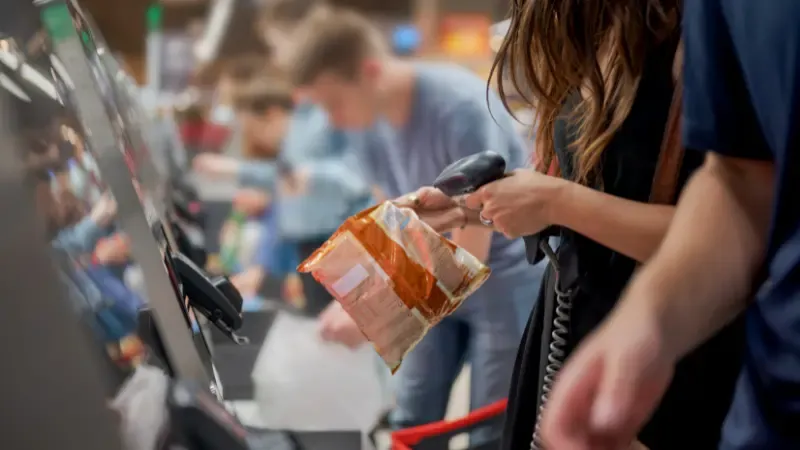
The POS is not just a payment tool. It integrates with inventory systems, customer relationship management (CRM), and loyalty programs. A retailer can instantly see when stock levels are low, track repeat customers, or trigger targeted promotions.
With real-time analytics, the POS becomes a decision engine. It highlights sales trends, uncovers peak hours, and supports staffing plans. Managers gain a live view of what is happening across stores.
The competitive edge lies in speed and personalization. A fast checkout reduces wait times and fosters loyalty.
A connected POS tailor offers a tailored experience to specific customers.
For retailers facing pressure from both online and physical competition, the POS is now a central driver of efficiency and growth.
Types of POS Systems Explained
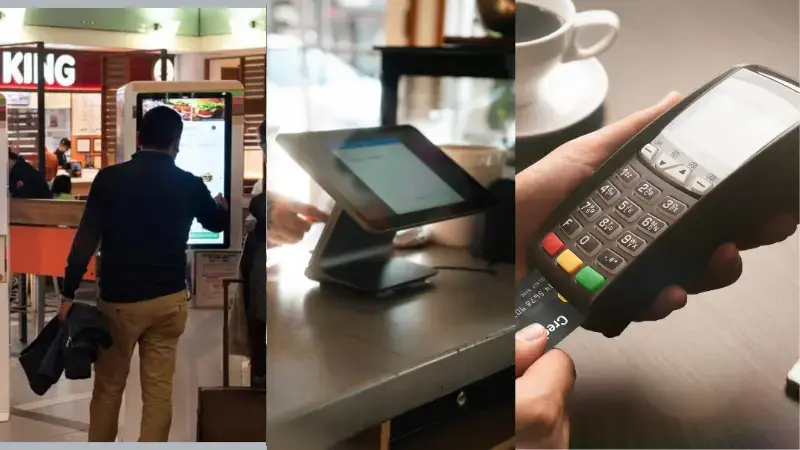
Not every POS system serves the same retail need. Some systems serve small outlets with simple checkouts. Others support complex, multi-location operations.
Choosing the right type helps retailers and partners align technology with business goals.
Traditional POS Systems: Legacy but Limited
Traditional POS systems run on on-site servers and fixed hardware. They process transactions but lack deep integration with modern retail tools.
They remain in use in smaller shops or legacy setups where upgrades are slow to implement. But they do not scale well with growth.
Cloud-Based POS Systems: Scalable and Flexible
Cloud-based POS systems operate through SaaS platforms. Data stays online, and businesses manage everything centrally.
- Remote access for managers and staff at any location.
- Lower upfront investment compared to on-premise systems.
- Automatic updates with reduced IT overhead.
- Easier to scale for new stores or regions.
Best fit for franchises, retail chains, and multi-location businesses.
Mobile POS (mPOS): Portable and Quick
Mobile POS turns tablets and smartphones into checkout devices. They work with card readers or contactless options.
- Ideal for pop-up stores and seasonal kiosks.
- Enables in-aisle checkout in supermarkets or department stores.
- Supports delivery staff accepting payments at the customer’s door.
- Flexible setup without significant infrastructure costs.
This model provides retailers with agility, enabling them to reach customers wherever sales occur.
Self-Service Kiosks: Checkout Without Staff
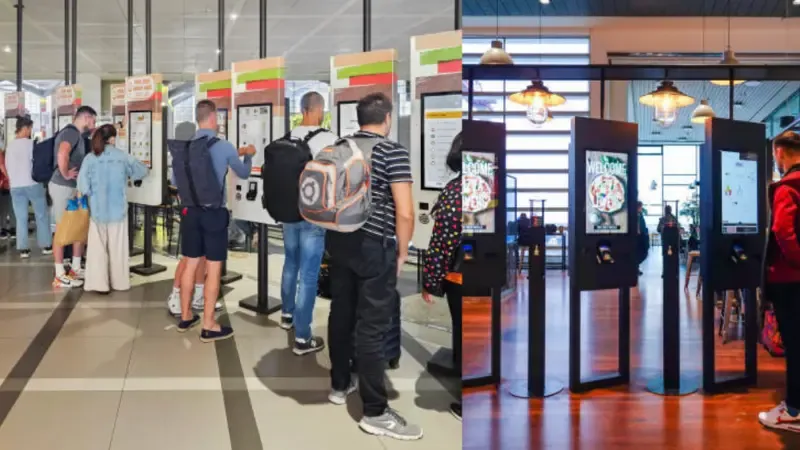
Self-service kiosks let customers handle their own transactions. They are widely used in supermarkets and quick-service restaurants. These systems cut labor costs and shorten lines during busy hours. They also free staff for service tasks. The model grows as retailers balance speed with staffing pressures.
The model is expanding as retailers balance customer demand for speed with the pressures of staffing.
Omnichannel POS: One System for All Sales
Omnichannel POS integrates online and in-store sales into a single system. It delivers a unified view of transactions, inventory, and customer activity. It supports BOPIS, syncs promotions across channels, and maintains accurate inventory across locations.
For retailers running hybrid models, this system ensures consistency and smooth operations.
Real-World POS System Examples
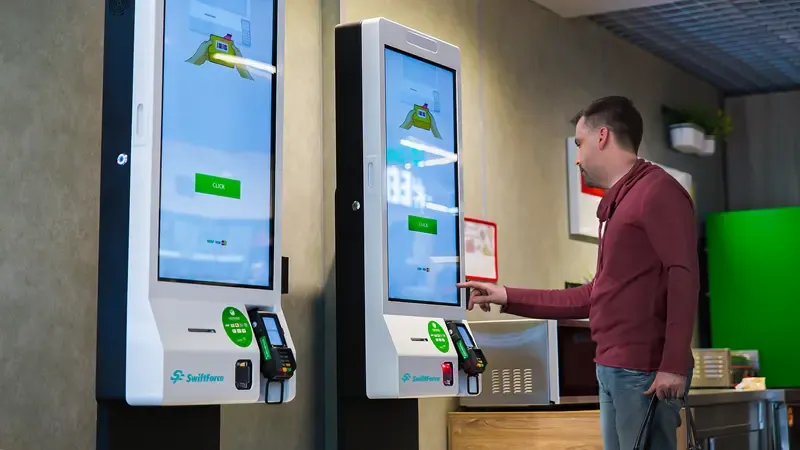
POS systems work differently across industries. Each setup depends on sales volume, customer flow, and integration needs. Here are practical examples of POS in retail and beyond.
Supermarkets and Large Retail Chains
Supermarkets rely on barcode scanners for a fast checkout process. POS connects with inventory in real time, so stock levels update automatically.
Systems also integrate with supply chain software to streamline replenishment. This reduces out-of-stock issues and improves efficiency at scale.
Restaurants and Cafés
Food service POS systems do more than process payments. They link to Kitchen Display Systems (KDS) for order management. Table service tools help staff assign, track, and close orders without confusion.
Many restaurants connect POS to online delivery platforms, so orders flow directly into the system. This eliminates manual entry and streamlines the service process.
Pop-Up Stores and Event Retail
Mobile POS systems are ideal for temporary setups, such as kiosks, markets, and festivals. They run on tablets or smartphones and use wireless connections for payments.
Portability matters more than heavy hardware. Quick setup and breakdown make them ideal for seasonal or mobile businesses.
These POS system examples demonstrate the flexibility of the technology. Retailers adapt POS to their environment, balancing speed, accuracy, and integration.
POS Terminals and Hardware Components
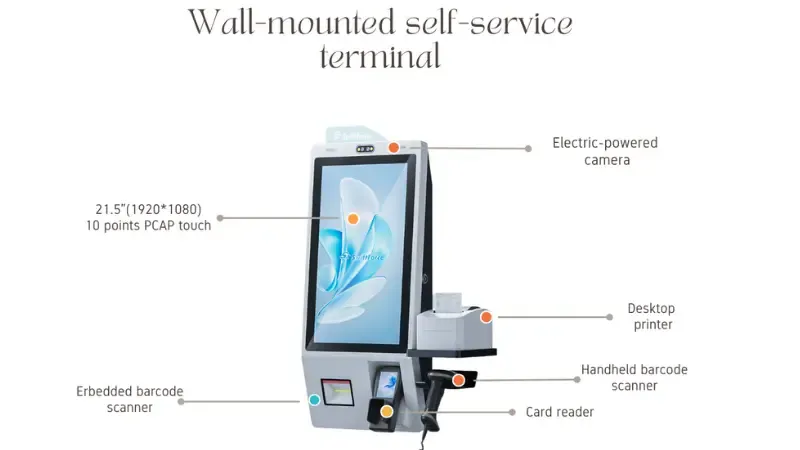
A POS system uses hardware to process sales, record transactions, and link retail operations. Each component has a specific role at checkout.
Together, they form the backbone of in-store payment and data collection.
Touchscreen terminal
The terminal is the central control unit. Staff use it to enter sales, view product data, and process payments. Modern terminals often run cloud-based software and support integrations.
Receipt printer
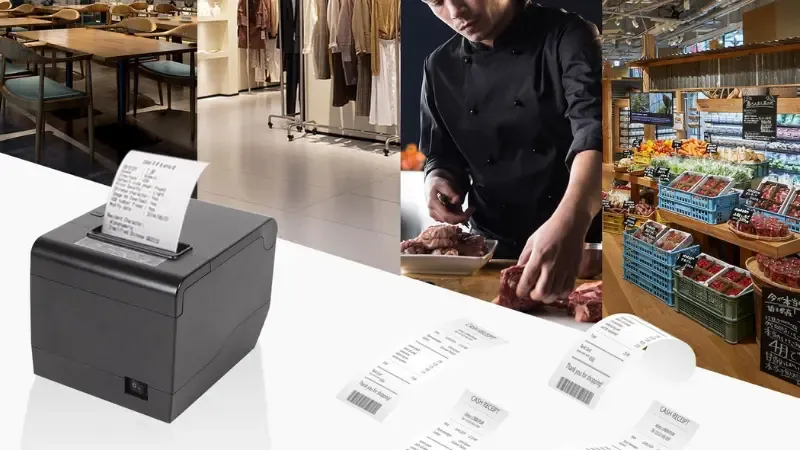
The printer provides customers with a paper receipt of their purchase. It also helps with returns and audits.
Many retailers now provide digital receipts. But paper receipts remain common in high-volume stores.
Barcode scanner
Scanners speed up checkout by reading product codes. They reduce errors from manual entry and keep inventory accurate. Handheld versions also support stock checks on the sales floor.
Payment processing device
These devices handle card swipes, chip transactions, and contactless payments. Security features, such as EMV compliance and encryption, protect both the retailer and the customer.
Cash drawer
Cash drawers remain essential where cash payments are frequent. They connect directly to the POS terminal and open only during approved transactions.
Optional peripherals
- Scales for items sold by weight.
- Customer-facing displays for price confirmation.
- Biometric login for staff authentication.
Future trend: all-in-one vs modular
Retailers now have the choice between all-in-one POS terminals and modular setups. All-in-one units combine a touchscreen, a printer, and a payment device into a single design. They save space and reduce setup time.
Modular systems enable retailers to swap or upgrade individual components. The choice depends on store size, budget, and future expansion plans.
POS in Retail: Key Use Cases & Advantages
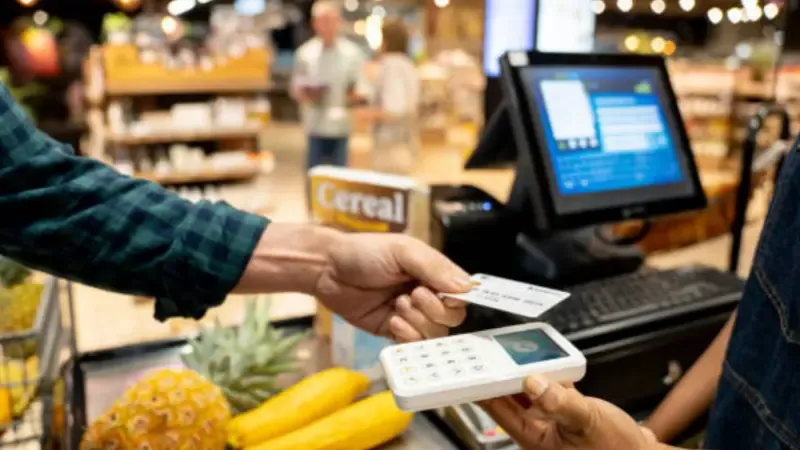
Point of Sale (POS) systems are more than just checkout tools. In retail, they improve efficiency, enhance customer engagement, and strengthen security. Below are the most common use cases and advantages.
Streamlining Checkout and Reducing Errors
A modern POS speeds up transactions. Cashiers scan items directly, which minimizes manual entry. This reduces mistakes and shortens wait times, making checkout smoother for both staff and customers.
Enhancing Customer Experience
Retailers can connect POS with loyalty programs and promotions. This allows stores to:
- Offer points, discounts, or rewards at checkout.
- Personalize promotions based on purchase history.
- Improve customer retention with seamless rewards integration.
Driving Insights Through Data Analytics
POS data enables retailers to understand their performance in real-time. Key uses include:
- Sales Forecasting: Predicting Demand and Stock Levels.
- Shrinkage prevention: Identify loss patterns and take corrective action.
- Trend analysis: Spot top-selling products and seasonal shifts.
Protecting Transactions and Preventing Fraud
Security is a core strength of modern POS in retail. Systems support:
- EMV chip payments for safer card transactions.
- PCI DSS compliance to protect customer data.
- Fraud monitoring tools that detect unusual activity.
POS systems in retail are not just transaction points. They provide retailers with tools to better serve customers, make smarter decisions, and keep payment data secure.
Choosing the Right POS System for Your Business

Choosing the right POS system depends on factors such as business size, industry, and growth goals. The wrong choice creates bottlenecks. The right choice streamlines operations and supports expansion.
Match to Business Size and Industry
Small retailers often need simple systems with core checkout features. Enterprise-level retailers may require advanced tools like multi-location support, analytics, and integrations. Always match the system to your operational scale.
Cloud vs. On-Premise Setup
- Cloud POS: Lower upfront cost, remote access, and easy scalability. Best for growing retailers or multi-location setups.
- On-Premise POS: Higher initial cost, but complete control over data and security. Often preferred by large retailers with strict compliance needs.
Hardware Compatibility
Verify if the POS is compatible with your existing hardware. Some systems integrate with existing terminals, scanners, and printers. Others may require a complete hardware upgrade. Compatibility reduces upfront costs.
Integration with Business Tools
POS should connect with tools like ERP, CRM, and eCommerce platforms. This creates a single source of truth for sales, inventory, and customer data. Integrated systems reduce manual work and errors.
Vendor Support and Scalability
Select a vendor that provides training, regular updates, and prompt support. Confirm that the POS can scale with your business, adding new features or locations when needed.
A POS point of sale system is a long-term investment. Retailers and resellers who align the system with business needs gain efficiency and future-proof their operations.
FAQs About Point of Sale Systems
What’s the difference between a POS and a cash register?
A cash register handles only payment collection. A POS system connects sales with inventory, reporting, and customer data. It supports multiple payment types and integrates with a range of business tools.
Is POS hardware or software?
POS is both. Hardware includes terminals, printers, and scanners. Software manages transactions, reporting, and integrations. Together, they create a complete system that enables retailers to process sales and run operations efficiently.
How secure are modern POS systems?
Modern POS platforms comply with PCI DSS and use encryption for card data. Many include fraud detection, role-based access, and automatic updates. Security relies on proper configuration, vendor support, and effective user practices.
Can POS work offline?
Yes. Many systems capture transactions offline and sync once the internet returns. Real-time reporting and cloud loyalty features may pause until connectivity is restored.
Which industries benefit most from POS upgrades?
Retail chains, restaurants, quick-service outlets, and healthcare providers see strong ROI. Upgraded POS systems improve checkout speed, reduce manual errors, integrate with loyalty tools, and provide better data visibility across locations.
Conclusion
Upgrading your POS is more than a tech refresh. It is a strategic decision that impacts sales, customer experience, and operational efficiency.
Whether you’re a software provider looking to integrate through APIs or white-label solutions, a distributor or agent ready to expand your product lineup, or a retail chain exploring more efficient operations, the right POS can make all the difference.
Ready to Upgrade Your POS?
Discover how SwiftForce can help you move forward with smarter POS solutions.Visit our homepage to explore our latest innovations, or contact us today to talk with our experts and find the best fit for your business.



